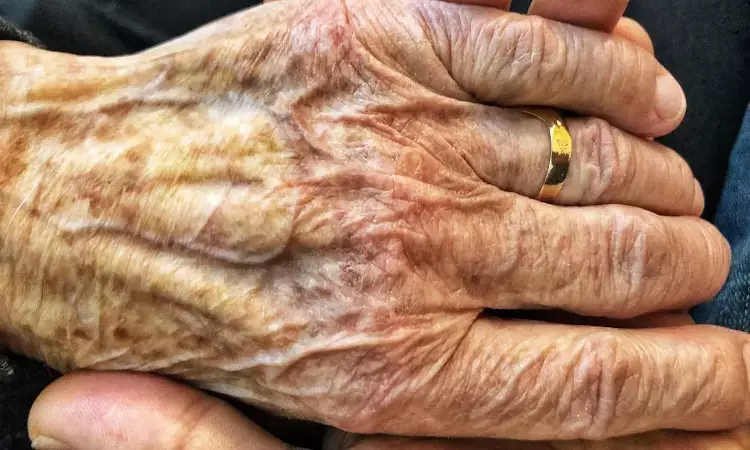- Home
- Medical news & Guidelines
- Anesthesiology
- Cardiology and CTVS
- Critical Care
- Dentistry
- Dermatology
- Diabetes and Endocrinology
- ENT
- Gastroenterology
- Medicine
- Nephrology
- Neurology
- Obstretics-Gynaecology
- Oncology
- Ophthalmology
- Orthopaedics
- Pediatrics-Neonatology
- Psychiatry
- Pulmonology
- Radiology
- Surgery
- Urology
- Laboratory Medicine
- Diet
- Nursing
- Paramedical
- Physiotherapy
- Health news
- Fact Check
- Bone Health Fact Check
- Brain Health Fact Check
- Cancer Related Fact Check
- Child Care Fact Check
- Dental and oral health fact check
- Diabetes and metabolic health fact check
- Diet and Nutrition Fact Check
- Eye and ENT Care Fact Check
- Fitness fact check
- Gut health fact check
- Heart health fact check
- Kidney health fact check
- Medical education fact check
- Men's health fact check
- Respiratory fact check
- Skin and hair care fact check
- Vaccine and Immunization fact check
- Women's health fact check
- AYUSH
- State News
- Andaman and Nicobar Islands
- Andhra Pradesh
- Arunachal Pradesh
- Assam
- Bihar
- Chandigarh
- Chattisgarh
- Dadra and Nagar Haveli
- Daman and Diu
- Delhi
- Goa
- Gujarat
- Haryana
- Himachal Pradesh
- Jammu & Kashmir
- Jharkhand
- Karnataka
- Kerala
- Ladakh
- Lakshadweep
- Madhya Pradesh
- Maharashtra
- Manipur
- Meghalaya
- Mizoram
- Nagaland
- Odisha
- Puducherry
- Punjab
- Rajasthan
- Sikkim
- Tamil Nadu
- Telangana
- Tripura
- Uttar Pradesh
- Uttrakhand
- West Bengal
- Medical Education
- Industry
Neurofilament Light may serve as new biomarker for Parkinson's Disease

In a new study conducted by Shannon Halloway and team it was seen that in a population-based sample, serum Neurofilament light (Nf-L) was linked to incident clinical Parkinson's disease (PD), parkinsonian symptoms, and physical functional decrease. The findings of this study were published in the journal of Neurology.
Blood biomarkers may help detect PD, parkinsonism, and poor Parkinson's disease related outcomes such as physical functioning early. Neurofilament light, a neuronal cytoplasmic protein, is a neurodegenerative biomarker that can be measured in biofluids. The goal of this study was to look at the relationship between serum Nf-L levels at the start of the study and clinically diagnosed Parkinson's disease, parkinsonian symptoms, and changes in physical functioning over the course of 16 years in a population-based sample of older persons.
The Chicago Health and Aging Project (CHAP), a longitudinal population-based research, provided all of the data for this experiment. Using a structured version of the United Parkinson's Disease Rating Scale, clinical examinations included measuring parkinsonian indicators in four domains: parkinsonian, bradykinesia, stiffness, gait, and tremors. PD was diagnosed by board-certified neurologists. Chair stands, tandem walks, and timed walks were used to test physical functioning. The proportion of Nf-L in blood was determined using an ultrasensitive immunoassay.
The key findings of this study were as follow:
1. In the study of 1,254 patients, 77 (6.1%) developed clinical PD, with parkinsonian symptoms averaging 9.5.
2. After controlling for demographics, the APOE-e4 allele, and global cognition, a 2-fold greater serum Nf-L concentration was related with incident clinical PD and global parkinsonian symptoms.
3. This relationship was substantial for at least five years prior to diagnosis.
4. Participants with serum Nf-L levels below 18.5 pg/mL at baseline had a higher odds ratio of clinical PD than those with levels between 18.5–25.4 pg/mL, 25.4–37.3 pg/mL, and above 37.3 pg/mL at all time intervals from the time of diagnosis to more than five years before diagnosis.
5. A greater serum Nf-L concentration was linked to a quicker rate of physical function decrease.
In conclusion, this study's findings show that Nf-L might be used as a biomarker for neurodegeneration, including Parkinson's disease outcomes.
Reference:
Halloway, S., Desai, P., Beck, T., Aggarwal, N., Agarwal, P., Evans, D., & Rajan, K. (2022). Association of Neurofilament Light With the Development and Severity of Parkinson Disease. In Neurology (p. 10.1212/WNL.0000000000200338). Ovid Technologies (Wolters Kluwer Health). https://doi.org/10.1212/wnl.0000000000200338
Medical Dialogues consists of a team of passionate medical/scientific writers, led by doctors and healthcare researchers. Our team efforts to bring you updated and timely news about the important happenings of the medical and healthcare sector. Our editorial team can be reached at editorial@medicaldialogues.in.
Dr Kamal Kant Kohli-MBBS, DTCD- a chest specialist with more than 30 years of practice and a flair for writing clinical articles, Dr Kamal Kant Kohli joined Medical Dialogues as a Chief Editor of Medical News. Besides writing articles, as an editor, he proofreads and verifies all the medical content published on Medical Dialogues including those coming from journals, studies,medical conferences,guidelines etc. Email: drkohli@medicaldialogues.in. Contact no. 011-43720751


